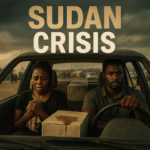

Sudan’s Crisis: A Call for Action
By Darius Spearman (africanelements)
Support African Elements at patreon.com/africanelements and hear recent news in a single playlist. Additionally, you can gain early access to ad-free video content.
The conflict in Sudan has created a humanitarian crisis of immense proportions, forcing millions from their homes. As of December 2024, the violence that began in mid-April 2023 had displaced over 12.3 million people (humanitarianaction.info). This staggering number is larger than the entire population of Switzerland, New York City, or London. The impact on the Sudanese people, many of whom are of African descent, is profound and heartbreaking. One in four Sudanese people are now forcibly displaced, and one in sixteen refugees globally are from Sudan (humanitarianaction.info). This crisis demands our urgent attention and understanding.
The term “forcibly displaced” refers to individuals compelled to leave their homes due to conflict, violence, human rights violations, or natural disasters (africacenter.org). This broad category includes internally displaced persons (IDPs), refugees, and asylum-seekers, each with distinct legal definitions and protections. Internally Displaced Persons (IDPs) are individuals who have been forced to flee their homes but remain within the borders of their own country. Unlike refugees, they have not crossed an international border and therefore do not fall under international refugee law, though they are protected by international humanitarian law and human rights law. More than 3 million people have fled to neighboring countries, including the Central African Republic, Chad, Egypt, Ethiopia, Libya, South Sudan, and Uganda, comprising refugees, asylum-seekers, and returnees (humanitarianaction.info). An estimated 8.4 million people are newly internally displaced within Sudan (humanitarianaction.info). Even prior to the recent conflict, over 13 million people in Sudan and its seven neighboring countries were already refugees or internally displaced (africacenter.org). The majority of internally displaced persons (79 percent) in Sudan were located in camps in Darfur, a region that has experienced renewed conflict and displacement after a genocide in the 2000s (africacenter.org).
Displacement Dynamics
The displacement crisis in Sudan is complex and ever-changing. There has been a significant return of individuals to Sudan, particularly from Egypt. Between January 1 and March 31, 2025, an estimated 72,039 individuals returned to Sudan from Egypt (reliefweb.int). This is a substantial increase compared to 42,418 returns during the entire year of 2024 (reliefweb.int). Since January 2024, an estimated total of 114,457 individuals have reportedly crossed back to Sudan from Egypt (reliefweb.int). The primary border crossing points for these movements were Ashkeet (87%) and Argeen (13%) (reliefweb.int). If the current monthly rate of return movements remains constant, hundreds of thousands of individuals may return to Sudan from Egypt within the next six months, depending on evolving dynamics (reliefweb.int).
Sudan’s Displacement Crisis
Returnees refer to individuals who have returned to their place of origin or habitual residence after being displaced. This can include refugees returning voluntarily to their home country, internally displaced persons returning to their homes, or in some cases, individuals who have been forcibly returned. The conditions and voluntariness of these returns are critical for understanding their sustainability and safety. The UNHCR is actively working with countries neighboring Sudan to address the increasing influx of Sudanese refugees and returnees, aiming to provide protection and support to those fleeing violence (unhcr.org). The Displacement Tracking Matrix (DTM), developed by the International Organization for Migration (IOM), monitors and tracks population movements and displacement. It collects data on the numbers, locations, vulnerabilities, and needs of displaced populations, as well as returnees, to inform humanitarian responses and programming. DTM typically involves various data collection methods, including surveys, key informant interviews, and direct observation in affected areas.
Humanitarian Challenges
The humanitarian situation in Sudan remains dire, with ongoing challenges in providing aid and addressing the needs of displaced populations. The conflict in Sudan has led to a significant increase in displacement, with humanitarian access being a critical challenge as “safe” areas frequently change (humanitarianaction.info). The territory of Sudan is divided into areas controlled by the Sudanese Armed Forces (SAF), Rapid Support Forces (RSF), and other non-state armed actors, which poses operational and protection challenges for humanitarian aid (reliefweb.int). Despite these constraints, humanitarian partners managed to scale up their response and reached 12.6 million people with some form of assistance (humanitarianaction.info). The Humanitarian Needs Response Plan (HNRP) is a strategic document developed by humanitarian organizations, often led by the United Nations, to identify the most pressing humanitarian needs in a crisis-affected country and outline a coordinated plan for addressing them. It details the number of people in need, the severity of their needs, and the financial resources required to deliver life-saving assistance and protection.
The UNDP has been present in Sudan for over four decades, working on partnerships and in-country experience (undp.org). The Darfur Community Peace and Stability Fund (DCPSF) is a multi-donor trust fund that supports community-level peacebuilding and conflict mediation in Darfur (undp.org). The UNDP relies entirely on voluntary contributions from UN Member States, multilateral organizations, and the private sector to achieve its mandate (undp.org). As the number of internally displaced persons (IDPs) continues to rise in areas like Gedaref, solar solutions are being implemented to enhance the safety of displaced families (undp.org). These solar solutions provide lighting and power, which can improve security in displacement camps, especially for women and children, and allow for essential services to operate more effectively.
Impact on Vulnerable Populations
The crisis disproportionately affects vulnerable populations, including children. While the provided data acknowledges the displacement of populations, including children, it does not specifically elaborate on the unique impacts of the crisis on children’s health, education, or protection. However, a UNICEF-supported study in Egypt focused on assessing access to healthcare, employment, and mental health, and later, access to education, for displaced Sudanese populations, which would include children (knowledge.unicef.org). The second round of the study in Egypt, conducted after the school year began, focused more on access to education for the displaced Sudanese population, which would directly impact children (knowledge.unicef.org). The lack of access to education can have long-term consequences, creating a lost generation and hindering future development.
Returns to Sudan from Egypt
The host countries for Sudanese refugees also face immense challenges. The seven refugee-hosting countries included in the Sudan Regional Refugee Response Plan (RRP) each face their own challenges, and their contexts vary significantly (humanitarianaction.info). Even before the current conflict, over 13 million people in Sudan and its neighbors were already displaced, and more than 40 million faced acute food insecurity, indicating pre-existing fragility in host countries (africacenter.org). Resources to assist displaced populations and those facing food insecurity will be further stretched due to the conflict, implying increased strain on services and economies (africacenter.org). This strain can lead to increased competition for resources, potentially impacting social cohesion within host communities.
International Response and Future Outlook
The UNHCR continues to monitor and report on the Sudan situation, providing updates on operational highlights and developments in Sudan and neighboring countries. The UNHCR publishes external updates on the Sudan situation, detailing key operational highlights and security developments (data.unhcr.org). These updates cover the situation in Sudan and neighboring countries, including Chad, Central African Republic (CAR), Ethiopia, Egypt, and South Sudan (data.unhcr.org). Flexible and sustained international support is critical to address urgent needs and lay the groundwork for longer-term solutions in Sudan (unhcr.org). Despite challenges, humanitarian partners were able to scale up their response across Sudan, reaching 12.6 million people with some form of assistance (humanitarianaction.info). The UNHCR is working with neighboring countries to respond to the growing influx of Sudanese refugees and returnees, indicating a coordinated international effort (unhcr.org).
Humanitarian Aid Efforts
The broader socioeconomic consequences of displacement on Sudan and neighboring countries are significant. Even before the current conflict, over 13 million people in Sudan and its seven neighbors were already refugees or internally displaced, and more than 40 million faced acute food insecurity, indicating pre-existing socioeconomic strain (africacenter.org). A study on the Sudanese displaced population in Egypt included assessments of access to employment and food consumption, and coping strategies, directly addressing socioeconomic aspects for displaced individuals (knowledge.unicef.org). The future projections for displacement remain uncertain, though the increasing returns from Egypt offer a glimmer of hope. However, without a sustainable end to hostilities and increased funding for humanitarian affairs, the crisis will continue to deepen. The international community must prioritize efforts to achieve lasting peace and stability in Sudan, ensuring that the Sudanese people, particularly those of African descent, can return home and rebuild their lives with dignity and security.
ABOUT THE AUTHOR
Darius Spearman has been a professor of Black Studies at San Diego City College since 2007. He is the author of several books, including Between The Color Lines: A History of African Americans on the California Frontier Through 1890. You can visit Darius online at africanelements.org.
